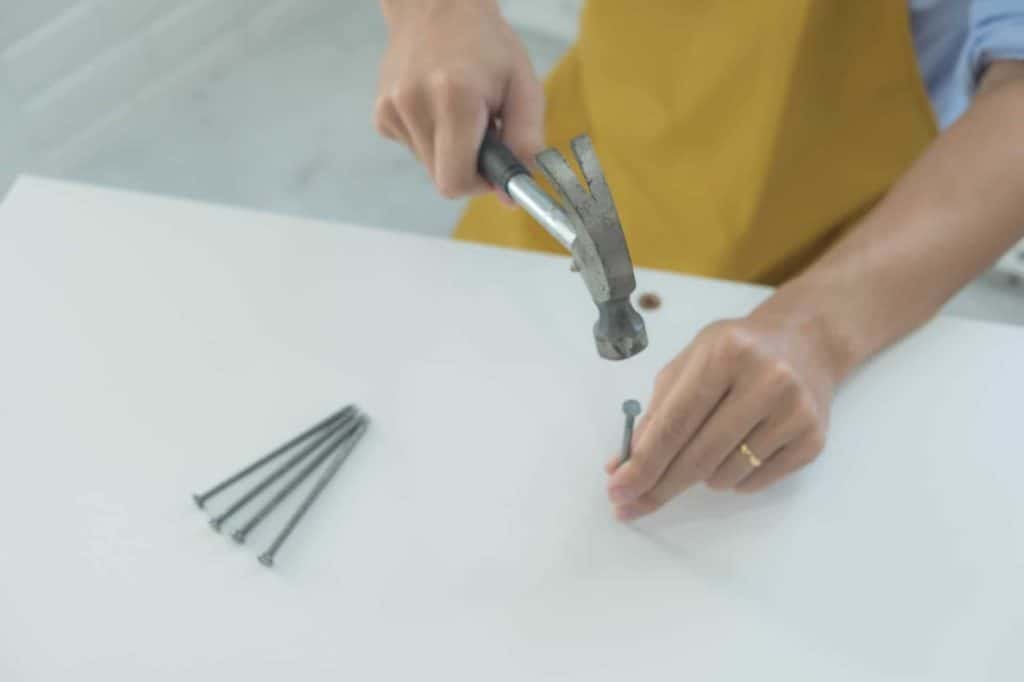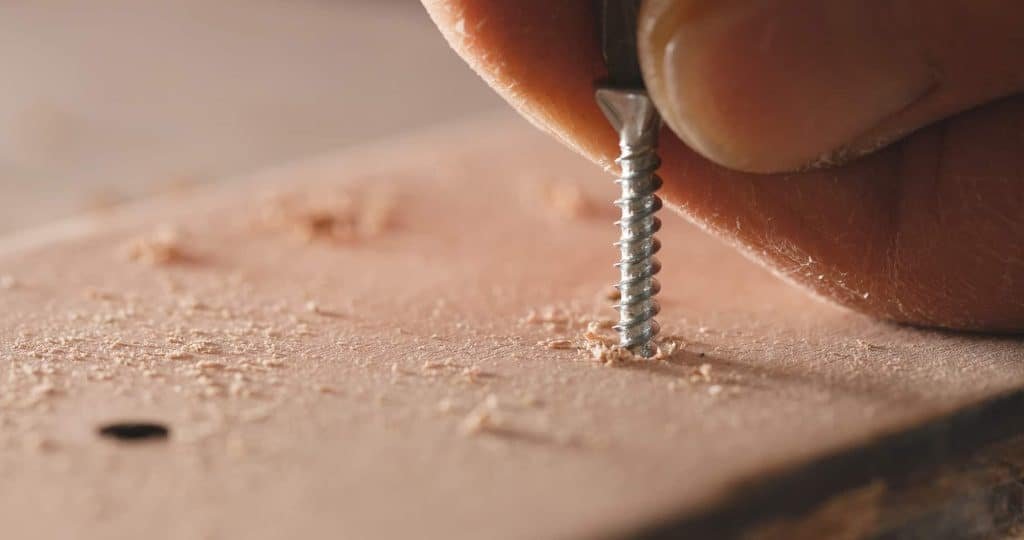Ever wondered if wood glue is stronger than using screws, or if you should use both together? In this article, I’ll discuss when wood glue is sufficient on its own, when to use both glue AND screws, and when screws by themselves are the best bet.
When Wood Glue Is Fine Without Screws
Let’s say that you need to build a shelf and glue it with wood glue. Should you be using wood screws or wood glue by itself?
The answer depends upon how much strength you want in your project. If you’re building a small piece of furniture (and I do mean small) then you can probably do fine without any fasteners at all, if it’s not going to bear a lot of weight.
However, if you’re making an entire bookshelf, then you may find yourself needing more support from the glued joints. You could also consider adding some additional wood supports as well.

Wood glue is more strong than screws when applied between two pieces of wood. Wood glue can grip the wood across the entire joint, while screws only hold it in a specific spot. The strength of the joint will be determined by the surface area available for wood glue to join. (abutterflyhouse.com)
In other words, if there isn’t enough space or area for wood glue to bond properly, then you won’t get very good results. This means that you might have to add extra supports to make sure that the whole thing holds up.
Wood glue also looks nicer and excess glue can be sanded off. So if aesthetics are important to you (more on this later), then glue is also a good choice.
If you decide to use wood glue alone, here are some tips:
1. Make sure that you buy high-quality wood glue. Cheap stuff just won’t work as well.
2. Prep your surface. Wood glue isn’t strong if you apply it directly onto unclean bare wood. Instead, sand down the surfaces a little first before applying the glue.
3. Let it cure overnight – Don’t be tempted to work with the glued joint too early. Wait until after the glue has had time to dry completely. Otherwise, you risk ruining the finished appearance of your project.
4. Wait longer after applying the last coat – Once you’ve finished gluing everything, allow the final coat to completely dry before removing any clamps.
Overall, glue alone does have its place, but if you want super strength…
When to Use Both Screws and Wood Glue
Wood glue and screws are not mutually exclusive – using both is the best way to guarantee a strong joint! This method should be used for projects such as attaching angled edges together or attaching small pieces of wood to larger ones that require extra strength at joints where two boards meet.
When using both wood glue and screws, it is best to drill pilot holes for each screw you intend to use before applying your glue. This will prevent the wood from splitting when gluing or screwing in a piece of wood that has not been pre-drilled.
Pro Tip: You should always check how long your wood glue is going to take to dry – here’s my article on that to help you out.
When working with thin materials – For example, plywood sheets, remember these tend to warp under pressure, especially when they aren’t attached securely. Therefore, you’d likely benefit from screwing them into place. But if you were trying to attach thick boards, then you wouldn’t really notice whether or not they warped.
When attaching multiple parts – Sometimes you’ll end up assembling several smaller components into something larger. In these cases, you’ll often see people recommend using screws instead of glues. The reason being that once you assemble the individual parts, you can simply remove them again later.
However, this approach comes with risks. First off, if you ever need to disassemble the assembly, then you’ll have to take care of each part separately. Secondly, if you ever accidentally damage one component during reassembly, then you’ll have no way of fixing things.
So what would you choose? Well, it depends on the situation. If you plan to keep the assembled unit intact forever, then you should definitely opt for screws. On the other hand, if you expect to dismantle the project regularly, then you should stick with glue.

When to Use Screws Without Wood Glue
Let’s face it, screws are unsightly unless you start making everything look like it came from Ikea, complete with the little plastic screw head covers!
Therefore if you want your project to look good, you’ll need to hide them for aesthetic reasons.
When using screws alone, woodworkers recommend that you use a countersink bit to drill pilot holes and then cover the screw heads with wooden plugs or dowel rods cut from scrap pieces of wood before finishing your project. You can also paint over them if desired!
If you’re looking to make an attractive finished product, then hiding the screws may be worth considering. However, if you just want to install some fasteners quickly, then there’s nothing wrong with leaving them exposed.
The other consideration is strength. Some joints are simply not strong enough to hold together if glued. This is especially true of pieces that will see a lot of stress, such as furniture with drawers and cabinet doors in general.
Let’s say you’re building an office desk for your home office out of wood – it makes sense to attach the legs using screws instead of glue because the desk will be subjected to a lot of use and you want it to last as long as possible.
This is because the screws can provide extra grip in this joint, which would not be strong enough if glued alone.
It’s important to note that glue should still be used on these joints for added strength if you like – just don’t expect the joint to hold together without screws!

How Do You Decide Between Wood Glue and Screws?
Woodworking projects come in all shapes and sizes, so deciding how much glue versus screws to use isn’t always easy.
Using both wood glue and screws provides the most secure joint. I always think of two factors – strength and the practical use of the project. Need it strong? Use both. Going to take it apart later? Just use screws. Need it to look good and never be disassembled? Use glue.
Here are some guidelines:
1) When installing large items, consider using both methods. It’s better to have more than one option available rather than relying solely on one method.
2) Use screws where necessary. They add stability and give you options for future repairs.
3) Consider the type of material you’re working with. Thin woods won’t require any additional support, but thicker ones might.
4) Remember that even if you’ve chosen to go with screws, you could still apply glue at the same time. Just make sure that you only use enough glue to fill the gap around the screw threads.
What About Nails Vs Screws?
Nails are another common choice for joining two surfaces together. While they work well for most applications, they lack the ability to pull apart easily after installation.
For instance, let’s say you wanted to build a set of shelves for your kitchen. Nailing those shelves together would probably suffice since they’re going to stay put anyway.
But suppose you needed to move them somewhere else down the road. Then you’d have to either break the nails loose first or risk damaging the surface underneath by driving new nails through it.
On the flip side, screws offer greater versatility.
Buy Quality No Matter Which One You Choose
If you’re going to use wood glue, choose a quality brand such as Titebond II so that you get a good result. Poor glues are as bad as not using glue at all, sometimes.
On the flip side, if you’re planning to use screws, cheap screws made of zinc alloy won’t hold up as long as stainless steel screws. Also, avoid galvanized nails and staples since they corrode easily.
Overall, I hope this article has helped clarify what types of fasteners are best suited for different situations. Me? I usually use both, because I want my projects to stay put – but I rarely do anything delicate, so if you’re after a finer finish, your choice may differ!

